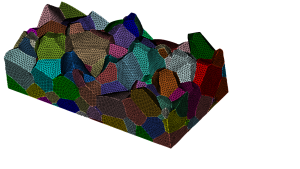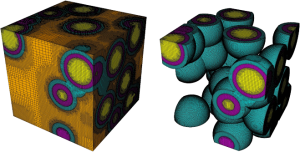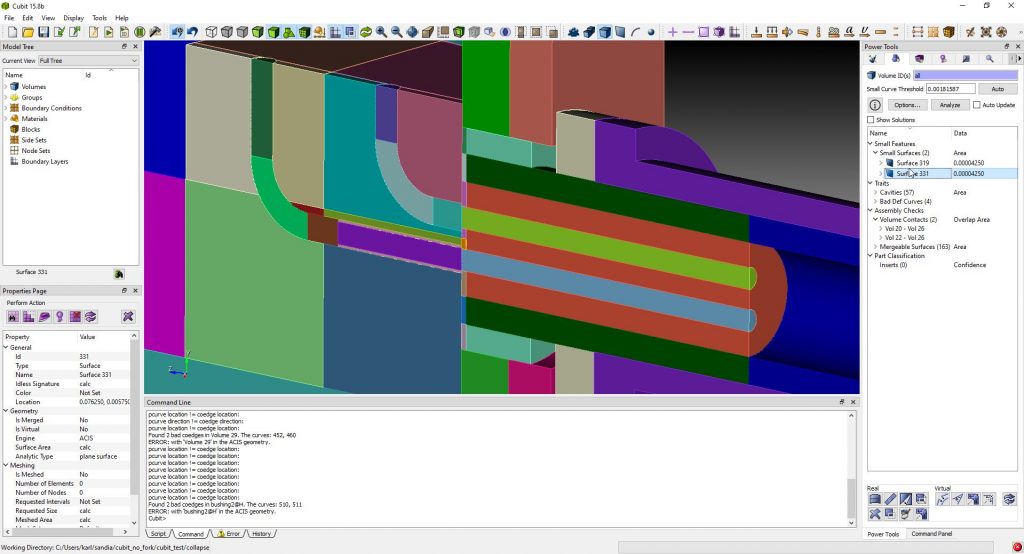Cubit® is a two- and three-dimensional finite element mesh generation toolkit for solid models. The goal of Cubit® is robust and unattended mesh generation of complex geometries, scalable to millions of elements and thousands of parts. Cubit® is best known for its pioneering work on automated quadrilateral and hexahedral mesh generation, but also maintains robust triangle and tetrahedral meshing technologies. Cubit® follows a toolkit approach, offering a variety of meshing techniques, and infrastructure and algorithms for interoperability. The software is used for both production mesh generation and as a research testbed.
Geometry Creation and Modification
- Geometric Primitives: Brick, cylinder, cone, sphere, prism, torus.
- Boolean Operations: Unite, subtract, intersect, imprint.
- Web-cutting: Tools for cutting and shaping geometry designed to facilitate complex mesh generation algorithms.
- Geometry Operators: Remove, extend, replace curves and surfaces, midsurface. Imprinting and merging.
- Healing: Automatically cleans many cases of invalid geometric entities and topology resulting from translation or model creation artifacts (with ACIS kernel).
- Non-Manifold Topology: Curves and surfaces merged to form shared entities. Allows conformal meshing of complex assemblies.
- Virtual Geometry: Does not modify geometry representation. Composite and partition of curves and surfaces. Collapse curve, surface and angle operators.
- Solid Model: ACIS solid modeling engine from Spatial Technology. Facet-based geometry kernel developed by Sandia.
- Geometry Power Tool: Diagnose problem geometry. Provides interactive tools for clean-up and repair.
Mesh Generation
- Mapped Meshing: 2D and 3D.
- Sub-mapping: 2D and 3D.
- Sweeping: one-to-one, many-to-one. Varying cross sections using weighted smoothing.
- Paving: Advancing front quad meshing.
- Trimesh: Advancing front surface triangulation.
- Hex Mesh Primitives: Circle, tetrahedron, pentagon, sphere, triangle.
- T-Hex: All hex mesh from subdivided tetrahedra.
- Tetmesh: Delaunay tetrahedral meshing (MeshGems by DISTENE).
- Mesh Operations: Copy, morph, mirror.
- Auto Scheme Selection: Chooses best quad or hex algorithm for geometry
- Auto Sweep Grouping: Chooses order to mesh volumes.
- Auto Interval Assignment: Chooses best number of nodes on curves for conformal meshing.
- Sizing Control: Curvature, bias, feature size, prescribed function from analysis results.
- Skew Control: Improves orthogonality of quad meshes.
- Smoothing: Laplacian, centroid-area pull, equipotential, Jacobian optimization, condition number optimization, Winslow, untangling.
- Mesh Quality: Jacobian, skew, taper, warp, aspect ratio, max/min angle, condition number, Oddy.
- Mesh Refinement: conformal hex, tet, quad and triangle. Global and local refinement options.
- Free Mesh: import and creation of mesh elements without geometry associativity
- Tet mesh cleanup: cleanup and improve existing tet meshes
- Mesh Editing: interactive mesh editing on free mesh, including deletion, merging, equivalence, transformations, etc.
User Interface
- Graphical User Interface: Point and click graphical selection and viewing. Cross-platform Qt-based environment.
- Power Tools: Provide interactive diagnostics and tools for cleaning up, meshing and verifying quality of a finite element model
- Immersive Topology Environment for Meshing (ITEM): Geometry preparation and meshing wizard
- Text Input/Output: All features available via command line.
- On-line Help: Browsable, HTML
- Journal Files: Echo, playback and batch mode.
- APREPRO: A scripting language for Cubit®.
- Python: Scripting language can be used to access internal Cubit® functionality through API.
Input/Output
- ACIS sat, sab: Geometry import/export
- Neutral formats: STEP, IGES
- Facet formats: STL, AVS, facet
- Exodus II: native mesh format
- Abaqus, Patran : mesh and boundary condition export.
- NASTRAN BDF, IDEAS Universal, Dyna3D, Fluent: mesh format export only
- Translators: Patran, Abaqus, IDEAS and others.
Boundary Conditions
- Exodus II: SideSets, nodesets and element blocks define generic loads and boundary conditions.
- ABAQUS, NASTRAN/PATRAN: interactive boundary condition definition and visualization
Availability/ Platforms
- Linux, Windows, macOS.
- Non-commercial: Non-commercial licenses are available for qualified universities. See https://coreform.com
- Commercial: see https://coreform.com/.



